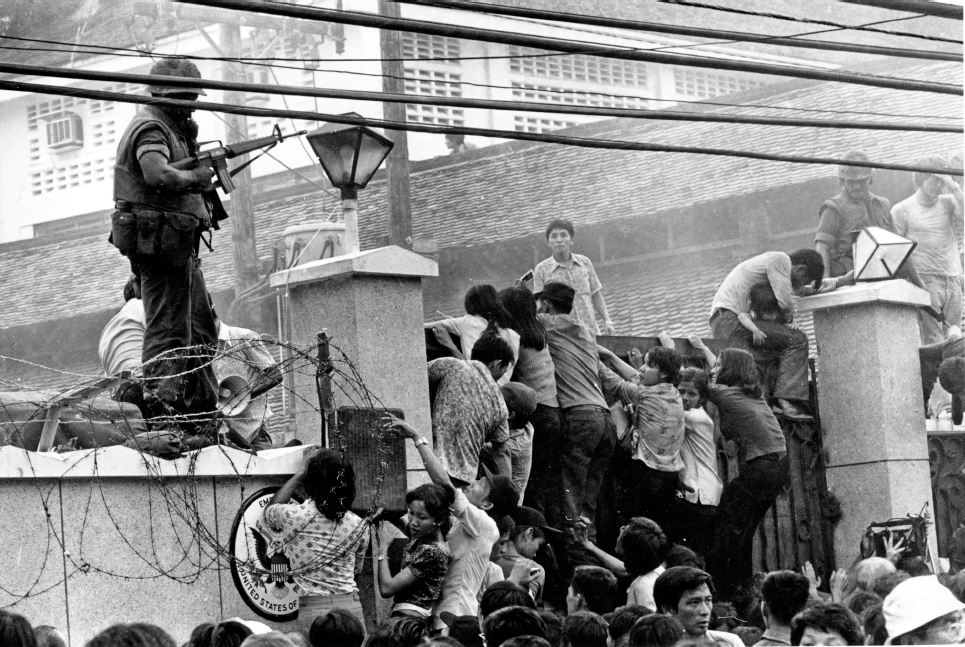The Failure of Vietnamization
Vietnam plagued Nixon as it had his Democratic predecessor. Despite intimations during the campaign that he had a secret plan to end the war, Nixon’s approach to Vietnam turned out to look much the same as Johnson’s. Henry Kissinger, who served first as national security adviser and then as secretary of state, continued peace talks with the North Vietnamese, which had been initiated by Johnson. Over the next four years, Nixon and Kissinger devised a strategy that removed U.S. ground forces and turned over greater responsibility for the fighting to the South Vietnamese army, a process called Vietnamization. (See e-Document Project 27: Debating the Vietnam War.)
Vietnamization did not, however, mean an end to U.S. belligerence in the region. In 1969, at the same time that American troop levels were being drawn down, the president ordered secret bombing raids in Cambodia, a neutral country adjacent to South Vietnam that contained enemy forces and parts of the Ho Chi Minh Trail. Meant to pressure the North Vietnamese into accepting U.S. peace terms, the bombing accomplished little in the mountainous jungle. In April 1970, Nixon ordered the invasion of Cambodia, which destabilized the country and eventually brought to power the Communist Khmer Rouge, who later slaughtered two million Cambodians. In 1971 the United States sponsored the South Vietnamese invasion of Laos, another neutral neighbor that harbored North Vietnamese troops and supply lines, which again yielded no battlefield gains. Finally, in December 1972, shortly before Christmas, the United States carried out a massive eleven-day bombing campaign of targets in North Vietnam meant to force the North Vietnamese government to come to a peace accord.
The intense bombing of North Vietnam did end formal U.S. involvement in the war. An agreement signed on January 27, 1973, stipulated that the United States would remove all American troops, the North Vietnamese would return captured U.S. soldiers, and North and South Vietnam would strive for peaceful national unification. Nixon and Kissinger could now claim that they had achieved “peace with honor,” ending U.S. involvement in Vietnam without compromising America’s credibility with its anti-Communist allies around the world. In fact, peace had not been achieved, and the United States had failed in its stated goal of preventing a Communist takeover of South Vietnam. The war in Vietnam continued, and in 1975 North Vietnamese and Vietcong forces captured Saigon, resulting in a Communist victory. This outcome came at a terrible cost. Some 58,000 American soldiers, 215,000 South Vietnamese soldiers, 1 million North Vietnamese and Vietcong soldiers, and an estimated 4 million South and North Vietnamese civilians were killed in the conflict.

The Nixon administration’s war efforts generated great controversy at home. In 1969 the president eliminated most draft deferments and introduced an impartial lottery system. This procedure was more equitable, but it exposed a wider range of young men to the draft. More important, the invasion of Cambodia touched off widespread campus demonstrations in May 1970. At Kent State University in Ohio, four student protesters were shot and killed by the National Guard. Large crowds of antiwar demonstrators descended on Washington in 1969 and 1971, though the president refused to heed their message. Nevertheless, the American public, and not just radicals, had turned against the war. By 1972 more than 70 percent of those polled believed that the Vietnam War was a mistake, and 31 percent disapproved of Nixon’s handling of it. Growing numbers of Vietnam veterans also spoke out against the war. Contributing to this disillusionment, in 1971 the New York Times and the Washington Post published a classified report known as the Pentagon Papers. This document, leaked by former Defense Department analyst Daniel Ellsberg, confirmed that the Kennedy and Johnson administrations had misled the public about the origins and nature of the Vietnam War. The Nixon administration tried, unsuccessfully, to block its publication. Congress reflected growing disapproval for the war by repealing the Gulf of Tonkin Resolution in 1970 after the Cambodian invasion. In 1973 Congress passed the War Powers Act, which required the president to consult with Congress within forty-eight hours of deploying military forces and to obtain a declaration of war from Congress if troops remained on foreign soil beyond sixty days. That same year, as the U.S. combat mission in Vietnam drew to a close, President Nixon disbanded the draft and created an all-volunteer military.